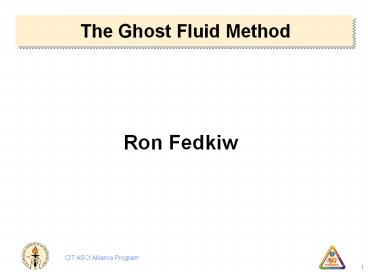The Ghost Fluid Method
1 / 29
Title:
The Ghost Fluid Method
Description:
Flames - Nguyen, Fedkiw, Kang. Stefan Problem - Fedkiw, Merriman, Chen ... Ghost Fluid Method - 2 phase flow. Tait EOS & Gamma Law Gas. CIT ASCI Alliance Program ... –
Number of Views:351
Avg rating:3.0/5.0
Title: The Ghost Fluid Method
1
The Ghost Fluid Method
Ron Fedkiw
2
Applications
Isobaric Fix - Fedkiw, Marquina,
Merriman Compressible Flow Contact
Discontinuities - Fedkiw, Aslam, Merriman,
Osher Deflagrations,Detonations, Shocks -
Fedkiw, Aslam, Xu Viscosity - Fedkiw, Liu,
Kang, Gibou Pulsating Detonation - Huang,
Aslam, Karagozian, Fedkiw Poisson Equation
Hele-Shaw Flow - Liu, Fedkiw, Kang,
Sideris Incompressible Flow Contact
Discontinuities - Kang, Fedkiw, Liu Flames -
Nguyen, Fedkiw, Kang Stefan Problem - Fedkiw,
Merriman, Chen Compressible\ Incompressible -
Caiden, Anderson, Fedkiw Eulerian\Lagrangian -
Fedkiw, Shepherd, Hung, Arienti
3
Isobaric Fix for wall overheating
Numerical Method appropriate pressure
and velocity
inappropriate entropy Inviscid Flow - no
boundary condition for entropy
- we are free to extrapolate entropy
Isobaric Fix
Density Errors
Patrick Hung
4
Contact Discontinuity
pressure velocity are continuous entropy is
discontinuous
Numerical Dissipation
Extrapolate Entropy
5
Ghost Fluid Method - 2 phase flow
Tait EOS Gamma Law Gas
6
Level Set Methods
keep track of the interface properties with the
signed distance function interface
location - two separate fluids -
unit normal - curvature -
moving the interface - signed distance
function - extrapolation -
continuous
and
interface velocity
extrapolated variable
7
Capturing the Boundary Conditions
Create a fictitious Ghost Fluid
Continuous Variables - copy them over from the
real fluid
in a node by node fashion
(pressure and normal
velocity) Discontinuous Variables - extrapolate
them from the fluid
on the other side of the interface
(entropy and tangential velocity) no slip
boundary condition - tangential velocity is
continuous thermal heat conduction - temperature
is continuous
8
Shock Contact Interaction
Tariq Aslam, LANL
interface (sharp)
shock
initial interface location
rarefaction
9
Computational Mesh
Cartesian Eulerian Mesh
Polygonal Lagrangian Mesh
Real Nodes
Ghost Nodes
10
Solution Triple
U - classical solution I - interface
representation B - boundary conditions Eulerian
Code U- mass, momentum, and energy _at_ real nodes I
- the level set function on the Cartesian mesh B
- mass, momentum, and energy _at_ ghost
nodes Lagrangian Code U - mass, velocity, and
pressure on the Lagrangian mesh I - polygonal
interface representation B - pressure (possibly
velocity) at points on the interface
11
Numerical Summary
dtmin(dt,dt)
(U,I,B)
(U,I,B)
Eulerian Code
Lagrangian Code
level set
I
U
I
U
I
interpolation
B
continuous
discontinuous
B
12
Solid-Fluid Coupling
Patrick Hung
13
Eulerian-Lagrangian Coupling (1D)
- Single shock wave propagating down shock-tube.
- Eulerian computational domain covers the entire
tube. - Lagrangian mesh covers the right most part of the
tube. - Eulerian-Lagrangian coupling using GFM.
- Boundary conditions Open/Closed
14
Numerical Methods.
- Eulerian computation based on Ron Fedkiws code.
- Perfect gas EOS.
- Completely independent of the Amrita environment.
- Uses a rectangular (non-AMR) cartesian mesh.
- Lagrangian computation.
- Artificial Viscosity (1D) (D.J. Benson)
- Entire program scripted using MATLAB.
- GFM
- Eulerian-Lagragian Pressure at the interface.
- Lagrangian-Eulerian Position and velocity of the
interface.
15
Eulerian-Lagrangian Coupling (1D)
- Initial Pressure Profile and Domain Specification.
16
Eulerian/Lagrangian (1D). Case 1.
- Right end fixed.
- Density in target (Lagrangian) twenty times
lower.
Pressure Profile
17
Eulerian/Lagrangian (1D). Case 2
- Right end free.
- Density in target (Lagrangian) twenty times
lower.
Pressure Profile and x-t Diagram
18
Eulerian/Lagrangian Coupling (2D)
- GFM is easily extended to 2D.
- Preliminary test cases performed with simplistic
solid models as proof-of-principle examples. - 1-D Mass elements along the length of the tube.
- 1-D Spring-mass elements along the length of the
tube. - The stiffness of the solid was arbitrarily
chosen. - Mass model Deformation of the tube highly
exaggerated. - Spring model Deformation of the tube not
visible.
19
Eulerian/Lagrangian Coupling (2D)
- Problem setup.
20
Eulerian/Lagrangian Coupling (2D)
- 1D mass elements used to represent the solid
tube.
Density Contours
21
Future Directions
- Migration to Python.
- 1D examples performed with MATLAB as the engine
driving Eulerian code written in C, and
Lagrangian code in MATLAB. - 2D examples in Fortran.
- Virtual Testing Facility.
- Detonation tube and the corner turning problem.
- Integration with the Solid Mechanics group to
replace the current simplistic Lagrangian
component. - Parallelization.
22
MG Eos and Ghost Fluid Method
Marco Arienti
23
Roadmap
- EoS for HE
Shock tube with GFM
Shock in HE hitting mass spring with GFM
K
24
Material characterization
- Mie-Grüneisen Equation of State
- Linear Up-us shock relation
- G, c0, s
25
Inert b-HMX shock tube
- P1105 , r11891, P2 2.109 , r22200 SI
units
velocity
pressure
density
26
Inert Kel-F shock tube experiment
- P1105 , r12133, P2 80.109 , r22633 SI
units
27
Inert b-HMX mass-spring system
- P11.0 105 Pa (right green)r1 1891. Kg/m3
- P2 9.8109 Pa (left green)r2 2400. Kg/m3
- solidEulerian code
- ENO method
- 3rd order Total Variation Diminishing Runge-Kutta
- density based GFM
- Interface gr from solid to fluid
28
Inert b-HMX mass-spring system
- Case 1 Ks1014 N/m, Ms103 Kg, Pg
105 Pa
pressure
density
29
Inert b-HMX mass-spring system
- Case 2 Ks1012 N/m, Ms5.102 Kg,
Pg 105 Pa
velocity
density
30
Future directions
Shock in reacting HE hitting mass spring with
GFM
Shock in reacting HE hitting Lagrangean solid
with GFM
Integration with 2D Lagrangean boundary































